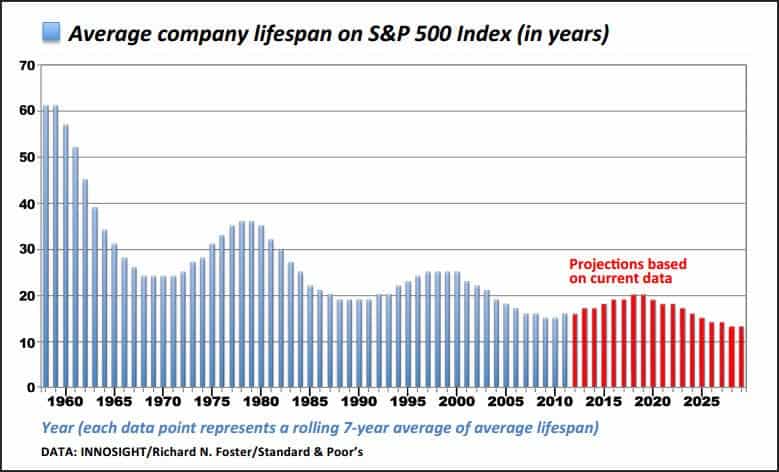“‘Your time is gonna’ come’ need not be your epitaph!” – Futurist Jim Carroll

Innovate or die.
It’s that simple.
Here’s a simple list of companies that were once great successes. Then they weren’t: Blockbuster. Borders. Lehman Bros. Kodak. Circuit City. RadioShack. Pan-Am. Enron. E.F. Hutton.RCA. Tower Records. Polaroid. Woolworths. Compaq. Arthur Anderson. The list could go on…. companies that were leaders in their time, and then failed, due to a lack of innovation; a failure to adapt; ethical problems; or other factors that could have been avoided.
In the next 10 years, we will see several established companies added to the list. We’ll also see a lot of medium and small-sized enterprises go the same way – except we won’t see them on such a list. They’ll just disappear in a swirl of emotional upset.
Right now, some of them could be making decisions to avoid that fate.
They aren’t.
Here’s some interesting food for thought from a great article on the issue of corporate longevity:
“The S&P 500 lists the 500 most valuable companies in the United States. Dick Foster, a McKinsey consultant, studied their average lifespan. It is a sobering tale that reminds us just how fast-paced business innovation has become. In 1937, the average tenure of companies on the list was 75 years. By 1960, it was 61 years. In 1980, 37 years. In 2000, 26 years. Today, an average of 15 years.”
If you are a senior executive, you need a serious gut check. Here you go:
Your chance for longevity and survival is shrinking. Disruption, business model change, and technological transformation are real, and so you have a simple choice: innovate or die.
Consider this: the average lifespan of companies on the Fortune 1000 list has been decreasing over the years. In the mid-20th century, companies stayed on the list for around 60 years on average. Today? Only 15 to 20 years. Think about this fun fact: it’s estimated that more than 50% of the Fortune 500 companies in the early 2000s have either gone bankrupt, merged, or fallen off the list! The numbers are equally bleak for small and medium-sized organizations. Studies show that 50% fail within the first five years, and only 30% survive more than 10 years*.
Those are some pretty long odds!
What’s the common thread? Organizations disappear because they don’t adapt – they don’t recognize the reality of the phrase “Innovate or die!’ They disappear because of technological innovation, market disruptions, intense competition, management failure, industry consolidation, or new business models that displace their own.
I know I have a lot of readers who have their own small company – and the message should be clear. Don’t presume that what you will be doing to thrive or survive ten years from now involves what you are doing today – you need to chase change. For those who work within larger organizations, double down on your efforts to lead disruptive thinking – and you will probably find others are thinking the same way. Band together like a band of brothers fighting a complex and lonely battle, but one that must be won.
Realize this – those who survive tomorrow are those who focus on adaptability, embracing innovation, and responding to disruptive change. Those that reinvent regularly. Those who know that tomorrow is not a given but something to be achieved.
Those who change.





GET IN TOUCH
Jim's Facebook page
You'll find Jim's latest videos on Youtube
Mastodon. What's on Jim's mind? Check his feed!
LinkedIn - reach out to Jim for a professional connection!
Flickr! Get inspired! A massive archive of all of Jim's daily inspirational quotes!
Instagram - the home for Jim's motivational mind!